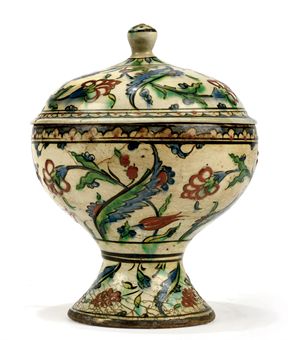Just finished studying Islamic ceramics and now I understand the process of creating lusterware and the differences between stone paste and earthenware, the influences of the Chinese arts via the silk route and the Mongol invaders and also the amazing inventiveness of the Islamic artists in both copying and creating new ideas.
Here are just a few of my favourites for you.

Tile
ca. 1525-50
Ottoman period
Stone-paste painted under glaze
H: 27.8 W: 24.4 D: 2.8 cm
Iznik, Turkey
More information here

Tile
ca. 1575
Ottoman period
Stone-paste body painted under glaze
H: 31.3 W: 30.0 D: 2.4 cm
Iznik, Turkey
More information here
If you are near Oxford consider a visit to the Ashmolean Museum or see more on their collection here.
The V&A has as online reading list for ceramics and glass and more dangerously I went on to discover an online reading list for Islamic textiles and dress! Eeekkk!!!
The book I have on the topic is by the wonderful John Gillow “Textiles of the Islamic World”

And other books from my C&G days (when I studied Moroccan and Turkish embroidery as one of my three countries – maybe I should have seen the interest in Islamic Art way back then. The third country was….. yes, its an easy guess. India, of course.)


And back to ceramics, there is a great collection in Stoke-on-Trent, you can see online here.
No doubt used for inspiration for the UK market.
This C17th covered bowl was sold at Christies in 2009 for £17,000 from the Ismail Merchant collection (as in Merchant – Ivory films, some of my all time favourites). You can spend an hour browsing this wonderful collection here.


Your posts on Islamic Arts have tickled my taste buds, so I just had a little look on Amazon and Moroccan Textile Embroidery is... £125! So for now I think I'll make do with a trip over to Oxford and see the Ashmolean collection. Thank you for the links, some wonderful items to drool over.
ReplyDelete